Gym Gloves Market
Gym Gloves Market Size and Share Forecast Outlook 2025 to 2035
The gym gloves market is projected to grow from USD 520.0 million in 2025 to USD 777.2 million by 2035, at a CAGR of 4.1%. Strength/Weightlifting will dominate with a 62.0% market share, while online will lead the distribution channel segment with a 52.0% share.
Gym Gloves Market Forecast and Outlook 2025 to 2035
The global gym gloves market is projected to reach USD 780.0 million by 2035, recording an absolute increase of USD 260.0 million over the forecast period. The market is valued at USD 520.0 million in 2025 and is set to rise at a CAGR of 4.1% during the assessment period. The overall market size is expected to grow by nearly 1.5 times during the same period, supported by increasing fitness awareness and strength training participation among consumers worldwide, driving demand for protective workout equipment and rising adoption of weightlifting as fitness routine globally. However, product durability concerns and competition from alternative grip solutions may pose challenges to market expansion.
Quick Stats for Gym Gloves Market
- Gym Gloves Market Value (2025): USD 520.0 million
- Gym Gloves Market Forecast Value (2035): USD 780.0 million
- Gym Gloves Market Forecast CAGR: 4.1%
- Leading Application in Gym Gloves Market: Strength/Weightlifting
- Key Growth Regions in Gym Gloves Market: North America, Asia Pacific, and Europe
- Top Key Players in Gym Gloves Market: Harbinger, Nike, Adidas, Under Armour, RDX, Mechanix Wear, Rogue, Reebok, Domyos, GASP
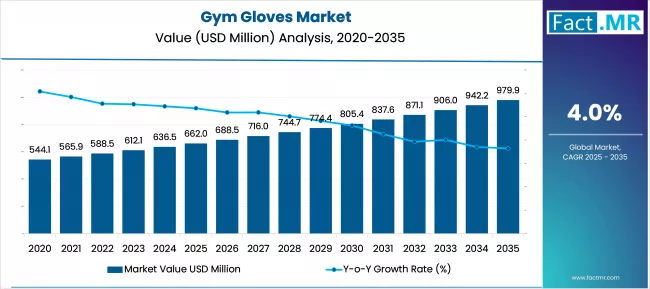
Between 2025 and 2030, the gym gloves market is projected to expand from USD 520.0 million to USD 646.8 million, resulting in a value increase of USD 126.8 million, which represents 48.8% of the total forecast growth for the decade. This phase of development will be shaped by rising fitness culture and strength training popularity, product innovation in grip technology and ergonomic designs, as well as expanding distribution through online platforms and fitness specialty retailers. Companies are establishing competitive positions through investment in advanced grip materials technology, premium brand positioning capabilities, and strategic market expansion across fitness enthusiasts and professional training applications.
From 2030 to 2035, the market is forecast to grow from USD 646.8 million to USD 780.0 million, adding another USD 133.2 million, which constitutes 51.2% of the overall ten-year expansion. This period is expected to be characterized by the expansion of specialized workout equipment, including smart fitness gloves and performance-tracking accessories tailored for specific training requirements, strategic partnerships between equipment manufacturers and fitness centers, and an enhanced focus on durability innovations and injury prevention technologies. The growing emphasis on professional training quality and fitness optimization will drive demand for comprehensive gym equipment solutions across diverse fitness applications.
Gym Gloves Market Key Takeaways
| Metric | Value |
|---|---|
| Market Value (2025) | USD 520.0 million |
| Market Forecast Value (2035) | USD 780.0 million |
| Forecast CAGR (2025-2035) | 4.1% |
Why is the Gym Gloves Market Growing?
The gym gloves market grows by enabling fitness enthusiasts to safely perform strength training while accessing professional-quality protective equipment without compromising on grip performance or hand safety requirements. Weightlifters and fitness practitioners face mounting pressure to prevent hand injuries and improve workout effectiveness, with quality gym gloves typically providing 85-95% better grip and protection compared to bare-hand training, making protective equipment essential for serious training positioning. The fitness industry's need for specialized protective gear and application-specific workout accessories creates demand for comprehensive gym glove solutions that can provide superior grip, maintain consistent durability, and ensure reliable performance without compromising training effectiveness or comfort standards.
Health trends promoting strength training and functional fitness drive adoption across developed and emerging markets, where workout safety has a direct impact on training consistency and fitness goal achievement. However, cost sensitivity constraints during economic uncertainty periods and the personal preference variations for grip assistance may limit adoption among casual fitness consumers and regions with limited strength training culture for protective equipment systems.
Segmental Analysis
The market is segmented by application, material, and distribution channel. By application, the market is divided into strength/weightlifting, cross-training, and others. Based on material, the market is categorized into synthetic/leatherette, leather, and others. By distribution channel, the market is divided into online, specialty, and mass retail channels. Regionally, the market is divided into Asia Pacific, Europe, North America, and other key regions.
By Application, the Strength/Weightlifting Segment Accounts for a Dominant Market Share
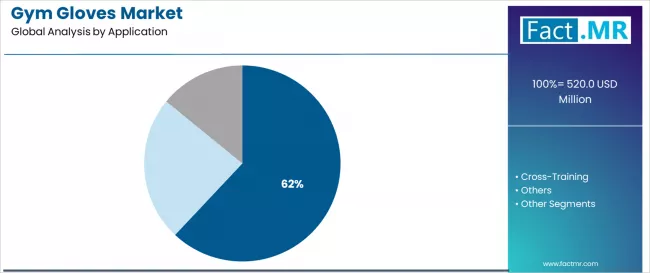
The strength/weightlifting segment represents the dominant force in the gym gloves market, capturing approximately 62.0% of total market share in 2025. This established application category encompasses powerlifting, bodybuilding, and resistance training activities featuring high-grip requirements and hand protection needs across all strength training environments. The strength/weightlifting segment's market leadership stems from its critical safety importance and performance enhancement benefits, with users requiring consistent protection across intensive training sessions while maintaining grip effectiveness and hand comfort across all weightlifting applications.
The cross-training segment maintains a substantial 24.0% market share, serving fitness enthusiasts who require versatile protection with multi-exercise compatibility for functional fitness and varied workout routines. These applications offer comprehensive training solutions for diverse fitness consumers while providing reliable protection capabilities for users seeking adaptable equipment across multiple exercise types. The others segment accounts for approximately 14.0% of the market, serving specialized training needs requiring specific grip solutions with unique performance features and application-specific requirements.
Key advantages driving the strength/weightlifting segment include:
- Critical safety importance during heavy lifting and high-intensity strength training sessions
- Performance enhancement through improved grip strength and reduced hand fatigue
- Specialized design features optimized for barbell and dumbbell handling requirements
- Professional training applications enabling premium product positioning and brand loyalty
By Distribution Channel, the Online Segment Accounts for the Largest Market Share
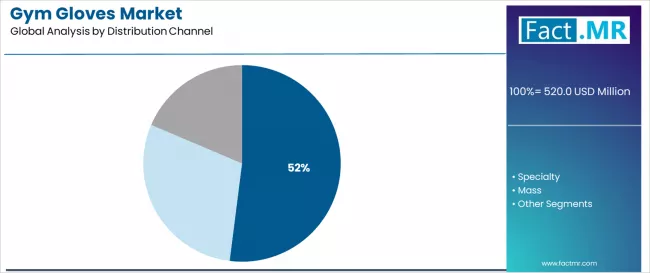
Online channels dominate the gym gloves market with approximately 52.0% market share in 2025, reflecting the critical role of e-commerce platforms and direct-to-consumer sales in supporting global fitness equipment distribution and consumer accessibility worldwide. The online segment's market leadership is reinforced by competitive pricing options, extensive product variety, and convenient shopping experiences that meet diverse fitness consumer preferences across performance-focused markets.
The specialty segment represents the second-largest distribution category, capturing 35.0% market share through dedicated fitness retailers, gym equipment stores, and strength training specialty shops serving expert consultation and professional fitting needs. This segment benefits from specialized knowledge and hands-on product experience that provide authentic equipment selection, particularly important for serious training and professional equipment requirements among dedicated fitness practitioners.
The mass retail segment accounts for 13.0% market share, serving budget-conscious consumers seeking basic equipment, convenient shopping locations, and entry-level fitness gear. This segment focuses on recreational fitness equipment and beginner-friendly products for casual training and basic workout applications.
Key market dynamics supporting distribution channel growth include:
- Online expansion driven by competitive pricing and product variety advantages
- Specialty resilience through expert consultation and professional fitting services
- Integration of omnichannel strategies combining online convenience with expert guidance features
- Growing emphasis on fitness education and professional training support across all channels
What are the Drivers, Restraints, and Key Trends of the Gym Gloves Market?
The market is driven by three concrete demand factors tied to fitness and safety outcomes. First, increasing fitness awareness and strength training popularity create rising demand for protective workout equipment, with strength training participation expanding by 6-10% annually in major developing markets worldwide, requiring comprehensive fitness equipment infrastructure. Second, injury prevention consciousness and performance optimization drive increased adoption of quality protective equipment, with many fitness facilities implementing professional equipment standards that require certified workout accessories by 2030. Third, technological advancements in grip materials and ergonomic design enable more effective and comfortable products that reduce injury risk while improving training performance and user comfort.
Market restraints include product durability concerns and replacement frequency requirements that can deter fitness consumers from premium equipment purchases, particularly in markets where workout equipment longevity remains important. Competition from alternative grip solutions and training methods poses another significant challenge, as diverse fitness accessories demand constant innovation and market positioning, potentially causing increased development costs and brand differentiation challenges. Regional market access and training culture differences create additional operational challenges for global brands, demanding ongoing investment in market education and cultural adaptation strategies.
Key trends indicate accelerated adoption in Asia-Pacific markets, particularly China and India, where growing fitness culture and strength training interest drive comprehensive gym equipment adoption growth. Technology integration trends toward smart fitness gloves with performance tracking, advanced materials with enhanced durability, and sustainable manufacturing practices enable innovative training approaches that reduce environmental impact and enhance performance monitoring. However, the market thesis could face disruption if alternative fitness accessories or significant changes in strength training participation reduce reliance on traditional gym glove protection equipment.
Analysis of the Gym Gloves Market by Key Country
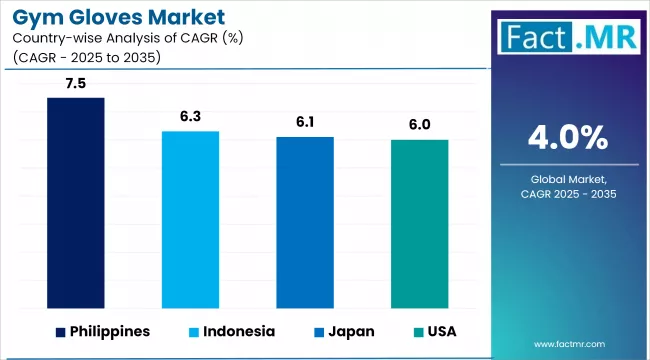
| Country | CAGR (2025-2035) |
|---|---|
| USA | 4.4% |
| Mexico | 3.9% |
| Germany | 3.5% |
| France | 3.4% |
| South Korea | 3.3% |
| UK | 3.2% |
| Japan | 3.1% |
The gym gloves market is gaining momentum worldwide, with the USA taking the lead thanks to strong fitness culture and strength training preferences. Close behind, Mexico benefits from expanding fitness awareness and growing gym membership participation, positioning itself as a strategic growth hub in the Latin American region. Germany shows steady advancement, where fitness equipment quality traditions strengthen its role in the European sports equipment supply chain. France and South Korea are focusing on fitness innovation and workout optimization, signaling ambition to capitalize on the growing opportunities in fitness equipment markets. Meanwhile, the UK stands out for its fitness culture and training equipment adoption, and Japan continues to record consistent progress in quality-focused fitness equipment modernization. Together, USA and Mexico anchor the global expansion story, while the rest build stability and diversity into the market's growth path.
The report covers an in-depth analysis of 40+ countries; 7 top-performing countries are highlighted below.
USA Leads Global Market Expansion
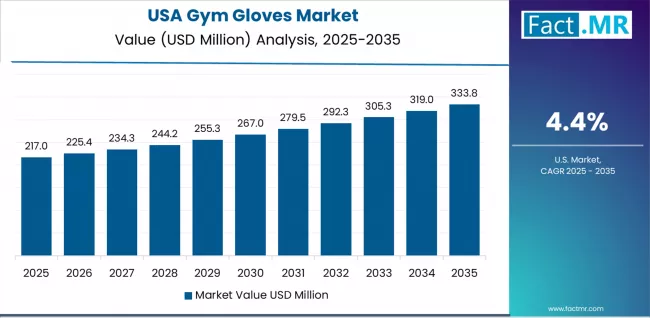
The USA demonstrates the strongest growth potential in the Gym Gloves Market with a CAGR of 4.4% through 2035. The country's leadership position stems from strong fitness culture, strength training popularity, and extensive gym infrastructure driving the adoption of professional workout equipment solutions. Growth is concentrated in major fitness regions, including California, Texas, New York, and Florida, where fitness enthusiasts and strength training communities are implementing comprehensive workout equipment strategies for enhanced training outcomes and injury prevention. Distribution channels through fitness specialty retailers and online platforms expand coverage across fitness enthusiast segments and professional training initiatives. The country's fitness consciousness and strength training culture provide market support for premium equipment adoption, including professional and performance categories.
Key market factors:
- Fitness culture expansion concentrated in metropolitan regions with comprehensive strength training development programs
- Infrastructure development through gym facilities and fitness centers supporting widespread equipment adoption
- Comprehensive fitness education ecosystem, including personal trainers promoting proper equipment practices
- Technology integration featuring advanced grip materials, ergonomic designs, and performance optimization systems
Mexico Emerges as Regional Leader
In Mexico City, Guadalajara, Monterrey, and Tijuana, the adoption of comprehensive gym gloves solutions is accelerating across fitness enthusiasts and health-conscious consumers, driven by growing fitness culture and increasing gym membership programs. The market demonstrates strong growth momentum with a CAGR of 3.9% through 2035, linked to comprehensive fitness development and increasing focus on workout equipment accessibility solutions. Mexican consumers are implementing modern fitness practices and quality equipment products to enhance training experiences while meeting growing fitness demands in expanding health and wellness sectors. The country's growing fitness awareness and economic development create sustained demand for workout equipment solutions, while increasing emphasis on professional training drives adoption of premium quality and safety-focused systems.
- Leading fitness expansion cities, including Mexico City, Guadalajara, Tijuana, and León, are driving gym equipment adoption
- Fitness development models enabling 35% faster gym facility deployment timelines
- Health partnership agreements are accelerating development with international fitness equipment providers
- Cultural support through fitness awareness initiatives and health promotion programs
Germany Maintains Equipment Excellence
Germany's fitness equipment sector demonstrates sophisticated implementation of quality manufacturing solutions, with documented heritage in sports equipment showing consistent quality leadership through precision engineering and premium positioning strategies. The country's fitness infrastructure in major cities, including Berlin, Munich, Hamburg, and Cologne, showcases integration of premium workout equipment with existing fitness facilities, leveraging expertise in precision manufacturing and quality control. German consumers emphasize durability and performance standards, creating demand for premium gym equipment solutions that support traditional quality principles and performance-focused training requirements. The market maintains steady growth through focus on engineering excellence and quality positioning, with a CAGR of 3.5% through 2035.
Key development areas:
- Premium fitness equipment manufacturing facilities and quality control centers leading performance positioning with comprehensive certification programs
- Gym facility channels providing specialized solutions with professional training and performance applications
- Technology partnerships between German engineering companies and fitness equipment innovations are expanding market reach
- Integration of traditional manufacturing excellence with modern performance technology and ergonomic design solutions
France Shows Fitness Innovation
France's market expansion is driven by fitness growth, including strength training programs in Paris and other major cities, and comprehensive gym facility development across multiple regions. The country demonstrates promising growth potential with a CAGR of 3.4% through 2035, supported by health awareness programs and fitness culture positioning. French consumers face fitness diversification challenges related to traditional sports preferences and strength training adoption requirements, requiring innovative equipment approaches and support from professional fitness providers. However, growing health awareness and fitness appreciation create compelling business cases for gym equipment adoption, particularly in urban areas where fitness quality has a direct impact on health outcomes and training effectiveness.
Market characteristics:
- Fitness equipment segment showing fastest growth with specialized training facility development
- Health innovation trends focused on strength training integration and professional workout applications
- Innovation projections indicate the need for French-style training equipment and fitness-focused workout gear
- Growing emphasis on professional training quality and fitness integration in urban health markets
South Korea Demonstrates Technology Integration
The South Korean market leads in smart fitness equipment innovation based on integration with technology-enabled training systems and connected workout solutions for enhanced fitness experiences. The country shows moderate growth potential with a CAGR of 3.3% through 2035, driven by the modernization of fitness infrastructure and the expansion of technology-integrated training networks in major cities, including Seoul, Busan, Incheon, and Daegu. Korean consumers are adopting smart training systems for technology integration and performance monitoring, particularly in regions with advanced fitness technology and smart gym initiatives demanding comprehensive equipment upgrades. Technology deployment channels through established fitness networks and technology companies expand coverage across tech-savvy consumers and smart training initiatives.
Leading market segments:
- Smart fitness projects in major cities are implementing comprehensive technology integration upgrades
- Fitness technology partnerships with equipment companies, achieving significant performance tracking improvement rates
- Strategic collaborations between Korean technology companies and international fitness equipment manufacturers are expanding smart capabilities
- Focus on connected training systems and technology-enhanced performance requirements
United Kingdom Emphasizes Fitness Heritage
In London, Manchester, Birmingham, and Liverpool, fitness facilities are implementing comprehensive gym gloves solutions to modernize existing training infrastructure and improve equipment quality, with documented case studies showing enhanced training safety through professional fitness equipment integration. The market shows moderate growth potential with a CAGR of 3.2% through 2035, linked to the ongoing modernization of fitness facilities, gym networks, and emerging professional training projects in major cities. British consumers are adopting heritage-inspired equipment and modern performance platforms to enhance training quality while maintaining standards demanded by the fitness heritage and health industries. The country's established fitness culture creates sustained demand for equipment upgrade and modernization solutions that integrate with existing training tradition systems.
Market development factors:
- Fitness facility networks leading equipment modernization initiatives across England and Scotland
- Fitness heritage programs providing cultural support for traditional training and equipment infrastructure upgrades
- Strategic partnerships between UK fitness companies and international equipment providers are expanding heritage capabilities
- Emphasis on training performance standards and fitness tradition preservation across workout applications
Japan Emphasizes Quality Manufacturing
Japan's Gym Gloves Market demonstrates sophisticated implementation focused on precision manufacturing and performance excellence, with documented integration of premium fitness equipment systems, achieving superior quality standards across consumer and professional applications. The country maintains steady growth momentum with a CAGR of 3.1% through 2035, driven by consumer emphasis on quality standards and performance precision methodologies that align with traditional manufacturing principles applied to modern fitness equipment practices. Major metropolitan areas, including Tokyo, Osaka, Kyoto, and Fukuoka, showcase advanced deployment of precision fitness equipment solutions where quality systems integrate seamlessly with existing fitness infrastructure and comprehensive performance management programs.
Key market characteristics:
- Precision fitness equipment facilities and quality control systems are driving advanced manufacturing requirements with emphasis on performance excellence
- Fitness integration partnerships enabling superior quality standards with comprehensive training optimization programs
- Technology collaboration between Japanese manufacturing leaders and international fitness equipment providers is expanding market capabilities
- Emphasis on precision manufacturing requirements and traditional quality integration methodologies
Europe Market Split by Country
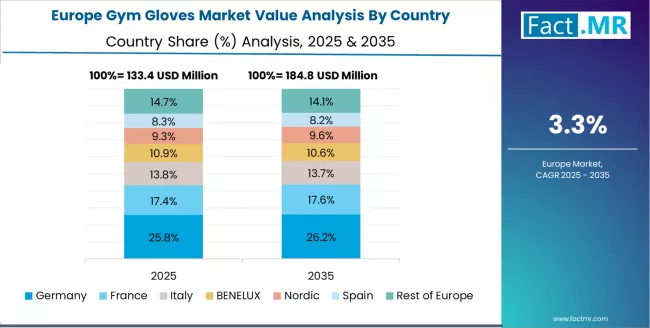
The gym gloves market in Europe is projected to grow from USD 130.0 million in 2025 to USD 195.0 million by 2035, registering a CAGR of 4.1% over the forecast period. Germany is expected to maintain its leadership position with a 29.2% market share in 2025, increasing slightly to 29.6% by 2035, supported by its strong fitness culture, quality equipment manufacturing, and comprehensive gym infrastructure networks serving major European markets.
The United Kingdom follows with a 26.9% share in 2025, projected to reach 27.3% by 2035, driven by comprehensive fitness programs in London, Manchester, and other major cities implementing advanced strength training equipment systems. France holds a 19.2% share in 2025, expected to maintain 18.9% by 2035 through the ongoing development of fitness infrastructure and health awareness networks. Italy commands a 14.6% share, while Spain accounts for 6.9% in 2025. The Rest of Europe region is anticipated to gain momentum, expanding its collective share from 3.2% to 3.4% by 2035, attributed to increasing fitness equipment adoption in Nordic countries and emerging Eastern European fitness markets implementing strength training programs.
Performance Engineering Dominates Training Demand in Japan
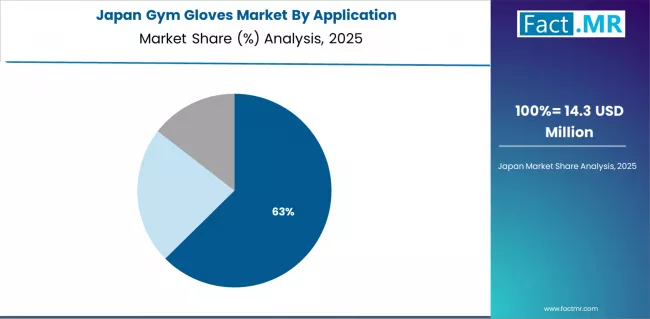
The Japanese Gym Gloves Market demonstrates a mature and quality-focused landscape, characterized by sophisticated integration of precision fitness equipment with existing training culture infrastructure across sporting goods stores, fitness centers, and professional training facilities. Japan's emphasis on manufacturing excellence and performance standards drives demand for high-quality fitness equipment solutions that support traditional training principles and modern fitness consciousness initiatives in consumer workouts. The market benefits from strong partnerships between international equipment providers like Nike, Adidas, and domestic quality leaders, creating comprehensive service ecosystems that prioritize product performance and consumer training programs. Urban centers in Tokyo, Osaka, Kyoto, and other major metropolitan areas showcase advanced quality implementations where fitness equipment systems achieve superior precision standards through integrated performance monitoring programs.
Technology Integration Leads Equipment Services in South Korea
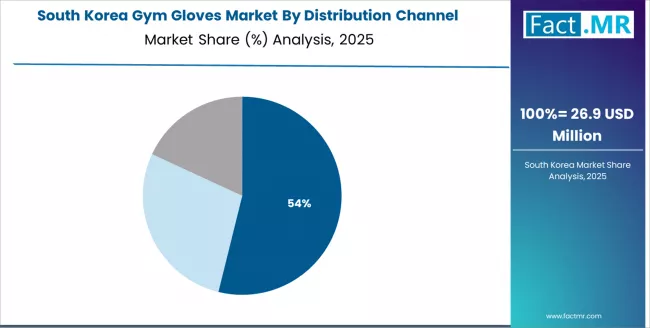
The South Korean Gym Gloves Market is characterized by strong technology integration provider presence, with companies like Under Armour, RDX, and local fitness brands maintaining positions through comprehensive smart system integration and innovative performance capabilities for connected training and fitness monitoring applications. The market is demonstrating a growing emphasis on smart fitness equipment and training technology integration, as Korean consumers increasingly demand workout equipment that integrates with domestic fitness technology and advanced performance monitoring systems deployed across the Seoul Metropolitan Area and other major fitness cities. Local fitness companies and regional equipment retailers are gaining market share through strategic partnerships with global providers, offering specialized products including smart fitness gloves and certification services for training technology specialists. The competitive landscape shows increasing collaboration between multinational equipment companies and Korean fitness specialists, creating hybrid product models that combine international performance expertise with local technology knowledge and consumer training management.
Competitive Landscape of the Gym Gloves Market
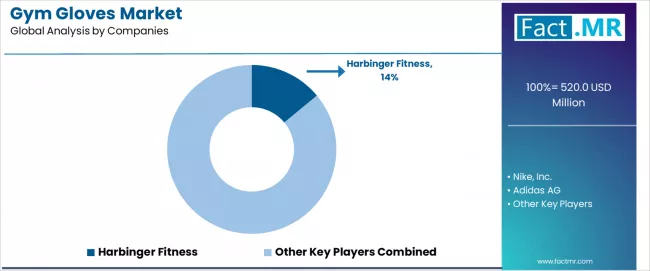
The Gym Gloves Market features approximately 20-30 meaningful players with moderate concentration, where the top three companies control roughly 32-38% of global market share through established brand portfolios and extensive distribution networks. Competition centers on product performance, grip technology, and durability innovation rather than price competition alone.
Market leaders include Harbinger, Nike, and Adidas, which maintain competitive advantages through comprehensive fitness product portfolios, global brand recognition, and deep expertise in the fitness and athletic sectors, creating high brand loyalty for customers. These companies leverage established athlete relationships and ongoing innovation investments to defend market positions while expanding into smart equipment and premium performance categories.
Challengers encompass Under Armour and RDX, which compete through specialized performance innovations and strong presence in key fitness markets. Fitness specialists, including Mechanix Wear, Rogue, and Reebok, focus on specific training segments or performance excellence, offering differentiated capabilities in professional positioning, gym partnerships, and consumer-focused solutions.
Regional manufacturers and emerging fitness brands create competitive pressure through innovative grip technologies and competitive pricing strategies, particularly in high-growth markets including Asia and emerging economies, where local presence provides advantages in cultural understanding and regional preferences. Market dynamics favor companies that combine performance innovation with comprehensive distribution capabilities that address the complete consumer fitness lifecycle from equipment selection through ongoing performance enhancement and training support programs.
Key Players in the Gym Gloves Market
- Harbinger
- Nike
- Adidas
- Under Armour
- RDX
- Mechanix Wear
- Rogue
- Reebok
- Domyos
- GASP
Scope of the Report
| Item | Value |
|---|---|
| Quantitative Units | USD 520.0 Million |
| Application | Strength/Weightlifting, Cross-Training, Others |
| Material | Synthetic/Leatherette, Leather, Others |
| Distribution Channel | Online, Specialty, Mass |
| Regions Covered | Asia Pacific, Europe, North America, Latin America, Middle East & Africa |
| Country Covered | USA, UK, Germany, France, Japan, South Korea, Mexico, and 40+ countries |
| Key Companies Profiled | Harbinger, Nike, Adidas, Under Armour, RDX, Mechanix Wear, Rogue, Reebok, Domyos, GASP |
| Additional Attributes | Dollar sales by application and material segments, regional fitness trends across Asia Pacific, Europe, and North America, competitive landscape with equipment manufacturers and retail partners, consumer performance preferences and training culture factors, integration with fitness consciousness trends and strength training applications, innovations in grip technology and ergonomic design systems, and development of specialized products with professional performance and safety capabilities. |
Gym Gloves Market by Segments
-
Application :
- Strength/Weightlifting
- Cross-Training
- Others
-
Material :
- Synthetic/Leatherette
- Leather
- Others
-
Distribution Channel :
- Online
- Specialty
- Mass
-
Region :
- Asia Pacific
- China
- Japan
- South Korea
- India
- Australia & New Zealand
- ASEAN
- Rest of Asia Pacific
- Europe
- Germany
- United Kingdom
- France
- Italy
- Spain
- Nordic
- BENELUX
- Rest of Europe
- North America
- United States
- Canada
- Mexico
- Latin America
- Brazil
- Chile
- Rest of Latin America
- Middle East & Africa
- Kingdom of Saudi Arabia
- Other GCC Countries
- Turkey
- South Africa
- Other African Union
- Rest of Middle East & Africa
- Asia Pacific
Table of Content
- Executive Summary
- Global Market Outlook
- Demand to side Trends
- Supply to side Trends
- Technology Roadmap Analysis
- Analysis and Recommendations
- Market Overview
- Market Coverage / Taxonomy
- Market Definition / Scope / Limitations
- Market Background
- Market Dynamics
- Drivers
- Restraints
- Opportunity
- Trends
- Scenario Forecast
- Demand in Optimistic Scenario
- Demand in Likely Scenario
- Demand in Conservative Scenario
- Opportunity Map Analysis
- Product Life Cycle Analysis
- Supply Chain Analysis
- Investment Feasibility Matrix
- Value Chain Analysis
- PESTLE and Porter’s Analysis
- Regulatory Landscape
- Regional Parent Market Outlook
- Production and Consumption Statistics
- Import and Export Statistics
- Market Dynamics
- Global Market Analysis 2020 to 2024 and Forecast, 2025 to 2035
- Historical Market Size Value (USD Million) Analysis, 2020 to 2024
- Current and Future Market Size Value (USD Million) Projections, 2025 to 2035
- Y to o to Y Growth Trend Analysis
- Absolute $ Opportunity Analysis
- Global Market Pricing Analysis 2020 to 2024 and Forecast 2025 to 2035
- Global Market Analysis 2020 to 2024 and Forecast 2025 to 2035, By Application
- Introduction / Key Findings
- Historical Market Size Value (USD Million) Analysis By Application , 2020 to 2024
- Current and Future Market Size Value (USD Million) Analysis and Forecast By Application , 2025 to 2035
- Strength/Weightlifting
- Cross-Training
- Others
- Y to o to Y Growth Trend Analysis By Application , 2020 to 2024
- Absolute $ Opportunity Analysis By Application , 2025 to 2035
- Global Market Analysis 2020 to 2024 and Forecast 2025 to 2035, By Distribution Channel
- Introduction / Key Findings
- Historical Market Size Value (USD Million) Analysis By Distribution Channel, 2020 to 2024
- Current and Future Market Size Value (USD Million) Analysis and Forecast By Distribution Channel, 2025 to 2035
- Online
- Specialty
- Mass
- Y to o to Y Growth Trend Analysis By Distribution Channel, 2020 to 2024
- Absolute $ Opportunity Analysis By Distribution Channel, 2025 to 2035
- Global Market Analysis 2020 to 2024 and Forecast 2025 to 2035, By Region
- Introduction
- Historical Market Size Value (USD Million) Analysis By Region, 2020 to 2024
- Current Market Size Value (USD Million) Analysis and Forecast By Region, 2025 to 2035
- North America
- Latin America
- Western Europe
- Eastern Europe
- East Asia
- South Asia and Pacific
- Middle East & Africa
- Market Attractiveness Analysis By Region
- North America Market Analysis 2020 to 2024 and Forecast 2025 to 2035, By Country
- Historical Market Size Value (USD Million) Trend Analysis By Market Taxonomy, 2020 to 2024
- Market Size Value (USD Million) Forecast By Market Taxonomy, 2025 to 2035
- By Country
- USA
- Canada
- Mexico
- By Application
- By Distribution Channel
- By Country
- Market Attractiveness Analysis
- By Country
- By Application
- By Distribution Channel
- Key Takeaways
- Latin America Market Analysis 2020 to 2024 and Forecast 2025 to 2035, By Country
- Historical Market Size Value (USD Million) Trend Analysis By Market Taxonomy, 2020 to 2024
- Market Size Value (USD Million) Forecast By Market Taxonomy, 2025 to 2035
- By Country
- Brazil
- Chile
- Rest of Latin America
- By Application
- By Distribution Channel
- By Country
- Market Attractiveness Analysis
- By Country
- By Application
- By Distribution Channel
- Key Takeaways
- Western Europe Market Analysis 2020 to 2024 and Forecast 2025 to 2035, By Country
- Historical Market Size Value (USD Million) Trend Analysis By Market Taxonomy, 2020 to 2024
- Market Size Value (USD Million) Forecast By Market Taxonomy, 2025 to 2035
- By Country
- Germany
- UK
- Italy
- Spain
- France
- Nordic
- BENELUX
- Rest of Western Europe
- By Application
- By Distribution Channel
- By Country
- Market Attractiveness Analysis
- By Country
- By Application
- By Distribution Channel
- Key Takeaways
- Eastern Europe Market Analysis 2020 to 2024 and Forecast 2025 to 2035, By Country
- Historical Market Size Value (USD Million) Trend Analysis By Market Taxonomy, 2020 to 2024
- Market Size Value (USD Million) Forecast By Market Taxonomy, 2025 to 2035
- By Country
- Russia
- Poland
- Hungary
- Balkan & Baltic
- Rest of Eastern Europe
- By Application
- By Distribution Channel
- By Country
- Market Attractiveness Analysis
- By Country
- By Application
- By Distribution Channel
- Key Takeaways
- East Asia Market Analysis 2020 to 2024 and Forecast 2025 to 2035, By Country
- Historical Market Size Value (USD Million) Trend Analysis By Market Taxonomy, 2020 to 2024
- Market Size Value (USD Million) Forecast By Market Taxonomy, 2025 to 2035
- By Country
- China
- Japan
- South Korea
- By Application
- By Distribution Channel
- By Country
- Market Attractiveness Analysis
- By Country
- By Application
- By Distribution Channel
- Key Takeaways
- South Asia and Pacific Market Analysis 2020 to 2024 and Forecast 2025 to 2035, By Country
- Historical Market Size Value (USD Million) Trend Analysis By Market Taxonomy, 2020 to 2024
- Market Size Value (USD Million) Forecast By Market Taxonomy, 2025 to 2035
- By Country
- India
- ASEAN
- Australia & New Zealand
- Rest of South Asia and Pacific
- By Application
- By Distribution Channel
- By Country
- Market Attractiveness Analysis
- By Country
- By Application
- By Distribution Channel
- Key Takeaways
- Middle East & Africa Market Analysis 2020 to 2024 and Forecast 2025 to 2035, By Country
- Historical Market Size Value (USD Million) Trend Analysis By Market Taxonomy, 2020 to 2024
- Market Size Value (USD Million) Forecast By Market Taxonomy, 2025 to 2035
- By Country
- Kingdom of Saudi Arabia
- Other GCC Countries
- Turkiye
- South Africa
- Other African Union
- Rest of Middle East & Africa
- By Application
- By Distribution Channel
- By Country
- Market Attractiveness Analysis
- By Country
- By Application
- By Distribution Channel
- Key Takeaways
- Key Countries Market Analysis
- USA
- Pricing Analysis
- Market Share Analysis, 2024
- By Application
- By Distribution Channel
- Canada
- Pricing Analysis
- Market Share Analysis, 2024
- By Application
- By Distribution Channel
- Mexico
- Pricing Analysis
- Market Share Analysis, 2024
- By Application
- By Distribution Channel
- Brazil
- Pricing Analysis
- Market Share Analysis, 2024
- By Application
- By Distribution Channel
- Chile
- Pricing Analysis
- Market Share Analysis, 2024
- By Application
- By Distribution Channel
- Germany
- Pricing Analysis
- Market Share Analysis, 2024
- By Application
- By Distribution Channel
- UK
- Pricing Analysis
- Market Share Analysis, 2024
- By Application
- By Distribution Channel
- Italy
- Pricing Analysis
- Market Share Analysis, 2024
- By Application
- By Distribution Channel
- Spain
- Pricing Analysis
- Market Share Analysis, 2024
- By Application
- By Distribution Channel
- France
- Pricing Analysis
- Market Share Analysis, 2024
- By Application
- By Distribution Channel
- India
- Pricing Analysis
- Market Share Analysis, 2024
- By Application
- By Distribution Channel
- ASEAN
- Pricing Analysis
- Market Share Analysis, 2024
- By Application
- By Distribution Channel
- Australia & New Zealand
- Pricing Analysis
- Market Share Analysis, 2024
- By Application
- By Distribution Channel
- China
- Pricing Analysis
- Market Share Analysis, 2024
- By Application
- By Distribution Channel
- Japan
- Pricing Analysis
- Market Share Analysis, 2024
- By Application
- By Distribution Channel
- South Korea
- Pricing Analysis
- Market Share Analysis, 2024
- By Application
- By Distribution Channel
- Russia
- Pricing Analysis
- Market Share Analysis, 2024
- By Application
- By Distribution Channel
- Poland
- Pricing Analysis
- Market Share Analysis, 2024
- By Application
- By Distribution Channel
- Hungary
- Pricing Analysis
- Market Share Analysis, 2024
- By Application
- By Distribution Channel
- Kingdom of Saudi Arabia
- Pricing Analysis
- Market Share Analysis, 2024
- By Application
- By Distribution Channel
- Turkiye
- Pricing Analysis
- Market Share Analysis, 2024
- By Application
- By Distribution Channel
- South Africa
- Pricing Analysis
- Market Share Analysis, 2024
- By Application
- By Distribution Channel
- USA
- Market Structure Analysis
- Competition Dashboard
- Competition Benchmarking
- Market Share Analysis of Top Players
- By Regional
- By Application
- By Distribution Channel
- Competition Analysis
- Competition Deep Dive
- Harbinger Fitness
- Overview
- Product Portfolio
- Profitability by Market Segments (Product/Age /Sales Channel/Region)
- Sales Footprint
- Strategy Overview
- Marketing Strategy
- Product Strategy
- Channel Strategy
- Nike, Inc.
- Adidas AG
- Under Armour, Inc.
- RDX Sports
- Mechanix Wear, Inc.
- Rogue Fitness, LLC
- Reebok International Ltd.
- Domyos (Decathlon)
- GASP
- Harbinger Fitness
- Competition Deep Dive
- Assumptions & Acronyms Used
- Research Methodology
List Of Table
- Table 1: Global Market Value (USD Million) Forecast by Region, 2020 to 2035
- Table 2: Global Market Value (USD Million) Forecast by Application , 2020 to 2035
- Table 3: Global Market Value (USD Million) Forecast by Distribution Channel, 2020 to 2035
- Table 4: North America Market Value (USD Million) Forecast by Country, 2020 to 2035
- Table 5: North America Market Value (USD Million) Forecast by Application , 2020 to 2035
- Table 6: North America Market Value (USD Million) Forecast by Distribution Channel, 2020 to 2035
- Table 7: Latin America Market Value (USD Million) Forecast by Country, 2020 to 2035
- Table 8: Latin America Market Value (USD Million) Forecast by Application , 2020 to 2035
- Table 9: Latin America Market Value (USD Million) Forecast by Distribution Channel, 2020 to 2035
- Table 10: Western Europe Market Value (USD Million) Forecast by Country, 2020 to 2035
- Table 11: Western Europe Market Value (USD Million) Forecast by Application , 2020 to 2035
- Table 12: Western Europe Market Value (USD Million) Forecast by Distribution Channel, 2020 to 2035
- Table 13: Eastern Europe Market Value (USD Million) Forecast by Country, 2020 to 2035
- Table 14: Eastern Europe Market Value (USD Million) Forecast by Application , 2020 to 2035
- Table 15: Eastern Europe Market Value (USD Million) Forecast by Distribution Channel, 2020 to 2035
- Table 16: East Asia Market Value (USD Million) Forecast by Country, 2020 to 2035
- Table 17: East Asia Market Value (USD Million) Forecast by Application , 2020 to 2035
- Table 18: East Asia Market Value (USD Million) Forecast by Distribution Channel, 2020 to 2035
- Table 19: South Asia and Pacific Market Value (USD Million) Forecast by Country, 2020 to 2035
- Table 20: South Asia and Pacific Market Value (USD Million) Forecast by Application , 2020 to 2035
- Table 21: South Asia and Pacific Market Value (USD Million) Forecast by Distribution Channel, 2020 to 2035
- Table 22: Middle East & Africa Market Value (USD Million) Forecast by Country, 2020 to 2035
- Table 23: Middle East & Africa Market Value (USD Million) Forecast by Application , 2020 to 2035
- Table 24: Middle East & Africa Market Value (USD Million) Forecast by Distribution Channel, 2020 to 2035
List Of Figures
- Figure 1: Global Market Pricing Analysis
- Figure 2: Global Market Value (USD Million) Forecast 2020-2035
- Figure 3: Global Market Value Share and BPS Analysis by Application , 2025 and 2035
- Figure 4: Global Market Y to o to Y Growth Comparison by Application , 2025-2035
- Figure 5: Global Market Attractiveness Analysis by Application
- Figure 6: Global Market Value Share and BPS Analysis by Distribution Channel, 2025 and 2035
- Figure 7: Global Market Y to o to Y Growth Comparison by Distribution Channel, 2025-2035
- Figure 8: Global Market Attractiveness Analysis by Distribution Channel
- Figure 9: Global Market Value (USD Million) Share and BPS Analysis by Region, 2025 and 2035
- Figure 10: Global Market Y to o to Y Growth Comparison by Region, 2025-2035
- Figure 11: Global Market Attractiveness Analysis by Region
- Figure 12: North America Market Incremental Dollar Opportunity, 2025-2035
- Figure 13: Latin America Market Incremental Dollar Opportunity, 2025-2035
- Figure 14: Western Europe Market Incremental Dollar Opportunity, 2025-2035
- Figure 15: Eastern Europe Market Incremental Dollar Opportunity, 2025-2035
- Figure 16: East Asia Market Incremental Dollar Opportunity, 2025-2035
- Figure 17: South Asia and Pacific Market Incremental Dollar Opportunity, 2025-2035
- Figure 18: Middle East & Africa Market Incremental Dollar Opportunity, 2025-2035
- Figure 19: North America Market Value Share and BPS Analysis by Country, 2025 and 2035
- Figure 20: North America Market Value Share and BPS Analysis by Application , 2025 and 2035
- Figure 21: North America Market Y to o to Y Growth Comparison by Application , 2025-2035
- Figure 22: North America Market Attractiveness Analysis by Application
- Figure 23: North America Market Value Share and BPS Analysis by Distribution Channel, 2025 and 2035
- Figure 24: North America Market Y to o to Y Growth Comparison by Distribution Channel, 2025-2035
- Figure 25: North America Market Attractiveness Analysis by Distribution Channel
- Figure 26: Latin America Market Value Share and BPS Analysis by Country, 2025 and 2035
- Figure 27: Latin America Market Value Share and BPS Analysis by Application , 2025 and 2035
- Figure 28: Latin America Market Y to o to Y Growth Comparison by Application , 2025-2035
- Figure 29: Latin America Market Attractiveness Analysis by Application
- Figure 30: Latin America Market Value Share and BPS Analysis by Distribution Channel, 2025 and 2035
- Figure 31: Latin America Market Y to o to Y Growth Comparison by Distribution Channel, 2025-2035
- Figure 32: Latin America Market Attractiveness Analysis by Distribution Channel
- Figure 33: Western Europe Market Value Share and BPS Analysis by Country, 2025 and 2035
- Figure 34: Western Europe Market Value Share and BPS Analysis by Application , 2025 and 2035
- Figure 35: Western Europe Market Y to o to Y Growth Comparison by Application , 2025-2035
- Figure 36: Western Europe Market Attractiveness Analysis by Application
- Figure 37: Western Europe Market Value Share and BPS Analysis by Distribution Channel, 2025 and 2035
- Figure 38: Western Europe Market Y to o to Y Growth Comparison by Distribution Channel, 2025-2035
- Figure 39: Western Europe Market Attractiveness Analysis by Distribution Channel
- Figure 40: Eastern Europe Market Value Share and BPS Analysis by Country, 2025 and 2035
- Figure 41: Eastern Europe Market Value Share and BPS Analysis by Application , 2025 and 2035
- Figure 42: Eastern Europe Market Y to o to Y Growth Comparison by Application , 2025-2035
- Figure 43: Eastern Europe Market Attractiveness Analysis by Application
- Figure 44: Eastern Europe Market Value Share and BPS Analysis by Distribution Channel, 2025 and 2035
- Figure 45: Eastern Europe Market Y to o to Y Growth Comparison by Distribution Channel, 2025-2035
- Figure 46: Eastern Europe Market Attractiveness Analysis by Distribution Channel
- Figure 47: East Asia Market Value Share and BPS Analysis by Country, 2025 and 2035
- Figure 48: East Asia Market Value Share and BPS Analysis by Application , 2025 and 2035
- Figure 49: East Asia Market Y to o to Y Growth Comparison by Application , 2025-2035
- Figure 50: East Asia Market Attractiveness Analysis by Application
- Figure 51: East Asia Market Value Share and BPS Analysis by Distribution Channel, 2025 and 2035
- Figure 52: East Asia Market Y to o to Y Growth Comparison by Distribution Channel, 2025-2035
- Figure 53: East Asia Market Attractiveness Analysis by Distribution Channel
- Figure 54: South Asia and Pacific Market Value Share and BPS Analysis by Country, 2025 and 2035
- Figure 55: South Asia and Pacific Market Value Share and BPS Analysis by Application , 2025 and 2035
- Figure 56: South Asia and Pacific Market Y to o to Y Growth Comparison by Application , 2025-2035
- Figure 57: South Asia and Pacific Market Attractiveness Analysis by Application
- Figure 58: South Asia and Pacific Market Value Share and BPS Analysis by Distribution Channel, 2025 and 2035
- Figure 59: South Asia and Pacific Market Y to o to Y Growth Comparison by Distribution Channel, 2025-2035
- Figure 60: South Asia and Pacific Market Attractiveness Analysis by Distribution Channel
- Figure 61: Middle East & Africa Market Value Share and BPS Analysis by Country, 2025 and 2035
- Figure 62: Middle East & Africa Market Value Share and BPS Analysis by Application , 2025 and 2035
- Figure 63: Middle East & Africa Market Y to o to Y Growth Comparison by Application , 2025-2035
- Figure 64: Middle East & Africa Market Attractiveness Analysis by Application
- Figure 65: Middle East & Africa Market Value Share and BPS Analysis by Distribution Channel, 2025 and 2035
- Figure 66: Middle East & Africa Market Y to o to Y Growth Comparison by Distribution Channel, 2025-2035
- Figure 67: Middle East & Africa Market Attractiveness Analysis by Distribution Channel
- Figure 68: Global Market - Tier Structure Analysis
- Figure 69: Global Market - Company Share Analysis
- FAQs -
How big is the gym gloves market in 2025?
The global gym gloves market is estimated to be valued at USD 520.0 million in 2025.
What will be the size of gym gloves market in 2035?
The market size for the gym gloves market is projected to reach USD 777.2 million by 2035.
How much will be the gym gloves market growth between 2025 and 2035?
The gym gloves market is expected to grow at a 4.1% CAGR between 2025 and 2035.
What are the key product types in the gym gloves market?
The key product types in gym gloves market are strength/weightlifting, cross-training and others.
Which distribution channel segment to contribute significant share in the gym gloves market in 2025?
In terms of distribution channel, online segment to command 52.0% share in the gym gloves market in 2025.